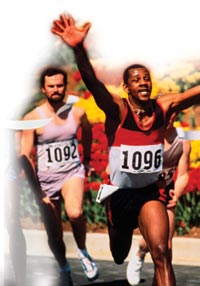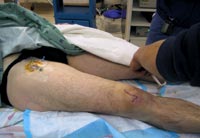Management of pain requires a combination of drugs
Pain relief in sports medicine has evolved to include multimodal and preemptive treatment.
Click Here to Manage Email Alerts
|
|
Mark D. Miller, MD is the co-director of sports medicine at the University of Virginia. |
An estimated 50 to 75 million Americans are affected by chronic pain, and another 25 million endure acute pain every year following surgery or injury.
A recent study in the Journal of the American Medical Association estimated that 13% of the American workforce experienced a loss in productive time during a two-week period due to pain. Headache was the most common pain condition and was followed by back pain (3.2%), arthritis pain (2.0%) and other musculoskeletal pain (2.0%).
Physicians struggle every day with the reality that these numbers represent, and sports medicine physicians face the challenge of pain as well when treating acute injuries like strains, sprains and ligament tears, or chronic injuries like tendonitis. Problems can be minimized by effectively managing pain preemptively as well as post-injury, and by ensuring that pain does not become chronic.
As with other areas of orthopedics, the management of pain in sports medicine has evolved greatly over the years, Jim Macintyre, MD, at Advanced Orthopaedics and Sports Medicine in Salt Lake City, told Orthopedics Today.
Antiinflammatories
“Everybody got full doses of anti-inflammatories when they walked in the door. If you had pain, you got anti-inflammatories whether or not there was any evidence of inflammation,” said Macintyre, a team doctor for the U.S Ski Team and U.S. Speed Skating.
|
NSAIDs are being prescribed much more sparingly because physicians now know they are not effective in many cases. In most soft tissues, inflammation is a first step in the healing process. But because there is no histologic evidence of inflammation, most tendon problems in athletes are not true tendonitis, but tendonosis or tendonopathy. So while the analgesic effect of NSAIDs will provide pain relief, it will not alter the underlying pathology. For conditions such as tenosynovitis or bursitis in which inflammation serves no useful purpose, NSAIDs can relieve inflammation and associated pain, Macintyre said.
Over the years, more refined indications for NSAIDs and the emergence of other drugs have led to combinations of medications, Macintyre said. “What we are going after now is multimodal pain management. The narcotics will act more centrally whereas the NSAIDs will act in a number of places, so you’re trying to block the pain at different sites.”
A multimodal approach can also be used to alleviate postsurgical pain, said Mark D. Miller, MD, co-director of sports medicine at the University of Virginia. “Some type of combination therapy is probably the best and has a synergistic effect. The problem with this is that it can be quite expensive and some of our HMOs may have a problem with that.”
Surgeons can also use local wound infiltration, peripheral nerve blocks with local anesthesia, NSAIDs, acetaminophen, systemic opioids, and epidural anesthetics and opioids. “These kinds of preemptive analgesia prevent central sensitization caused by incisional injury and inflammatory responses in the perioperative period,” Miller said. He presented his comments during an instructional course on pain management at the American Orthopaedic Society for Sports Medicine’s annual meeting in San Diego.
Local wound infiltration can be effective because it decreases nerve transmission from damaged tissue and decreases neurogenic inflammation. MacLeod et al at the University of British Columbia studied 23 patients who had arthroscopic cruciate ligament reconstructions under general anesthesia. The double-blind, randomized trial sought to reduce postoperative opioids by using combinations of local anesthetic infiltrations of the knee.
The treatment group of 12 patients received local infiltrations with bupivacaine 0.25% with epinephrine 1:200,000 presurgically and postsurgically. The control group of 11 patients received infiltrations with saline 0.9%. All patients received a standard intra-articular local anesthetic instillation of bupivacaine and epinephrine of the knee at the end of surgery.
Postoperative opioid requirements were lower in the treatment group than in the control group (P=.008); treatment patients were ready for discharge approximately 30 minutes earlier than control patients (P=.046). There were no adverse events in the treatment group. In the control group, two patients vomited and a third experienced transient postoperative diaphoresis, dizziness and pallor.
Regional blocks
Miller said there is a large amount of literature suggesting that regional blocks can be quite effective. Intraarticular morphine has been used as well, and a number of studies have been done, some yielding positive results, others negative.
A 2001 study by McCarty et al investigated whether intraarticular morphine improves pain control when used with a femoral nerve block. For the prospective, randomized, doubleblind study, 62 patients underwent arthroscopically assisted anterior cruciate ligament (ACL) reconstruction using patellar tendon autograft under general anesthesia.
 Researchers compared the effects
of preoperative intraarticular injection of 5 mg of morphine or a placebo,
combined with a postoperative femoral nerve block, on postoperative pain. There
was no statistical difference between the two groups preoperatively.
Researchers compared the effects
of preoperative intraarticular injection of 5 mg of morphine or a placebo,
combined with a postoperative femoral nerve block, on postoperative pain. There
was no statistical difference between the two groups preoperatively.
Comparison of visual analog scale pain scores revealed no statistical difference at any point after the operation, leading researchers to conclude that the femoral nerve block was effective and that intraarticular morphine provided no additional benefit.
Another option in the treatment of postoperative pain is oxycodone (OxyContin, Purdue Pharma L.P.), but it is clearly controversial due to fatal overdoses among illegal drug users. “The problem with this, of course, is all the hoopla in the press. Getting law enforcement involved is certainly not something you want to see in your practice,” Miller said.
Researchers at Tufts University School of Medicine published a study in 1999 evaluating the efficacy of controlled release (CR) oxycodone following outpatient ACL reconstruction. All patients received a standard general anesthetic and postoperative analgesic regimen with one of three oxycodone dosing regimens: 10 mg every four hours as needed, 10 mg every four hours, or 20 mg CR oxycodone every 12 hours.
At 24, 36, 48, 60 and 72 hours, patients in the CR group had less pain and were more alert. Over the 72-hour period, patients in the CR group consumed less oxycodone (P<.0001), had less sleep disturbance (P<.0001), were more satisfied (P<.0001) and experienced less vomiting (P<.02) than patients in the other two groups.
Miller said several principles have been developed for effective pain management using opioid therapy:
- Treat persistent pain with around-the-clock scheduled administration of long-acting agents.
- Treat breakthrough pain with short-acting agents as rescue therapy.
- Titrate dose to achieve the maximum desired level of pain relief.
- Use the least invasive route of administration (oral) first.
- Prophylax against and/or treat opioid-induced side effects.
|
COURTESY OF MARK D. MILLER |
Despite the best efforts of physicians, injuries treated operatively or nonoperatively can result in a complex regional pain syndrome (CRPS). According to Kenneth E. DeHaven, MD, paying attention to what patients are saying and putting the pieces of the puzzle together are crucial.
“I think the key is to have an index of suspicion and to pick up on the fact that there is pain and disability that is way out of proportion to the injury. Then you need to get them to people that can make a specific diagnosis,” said DeHaven, associate chair of the department of orthopedics at the University of Rochester Medical Center. DeHaven chaired the instructional course on pain management and sports medicine at the AOSSM meeting.
CRPS has a high frequency of resolving spontaneously by one year, and appropriate treatment in the first six months appears to shorten recovery time. But there can still be a 10% to 20% incidence of chronic pain that is difficult to treat and can persist for years.
DeHaven has learned “the hard way” that while many CRPS patients have pathologies that warrant treatment, surgical intervention will usually exacerbate their condition rather than improving it. “Our pain folks like to see them first, evaluate them and get them under maximal control before we do the intervention.”
While treating CRPS patients can be difficult, it can also be rewarding, DeHaven said. “These are among the most grateful patients that I see because someone has finally recognized this problem. Typically, they’ve been from pillar to post and nobody has picked up on the fact that the pain problem has been just as important, if not more important, than the musculoskeletal problem.”

![Mark D. Miller, MD [photo]](/~/media/images/news/print/orthopedics-today/2004/04_april/miller_70_90_1806.jpg)
